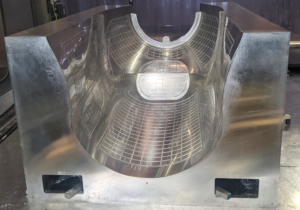An example of application that the machine can deliver, includes a 12-foot-long (3.6m) aerospace tool for the incredibly low material cost of $2,000, in less time than it took to additively print the same part.
Thermwood, the provider of large format 3D printing hardware and services with composite chopped Fiber Reinforced Polymer (FPR) pellet materials, introduces on the market a new manufacturing process.
Named “Cut Layer Additive”, the new addition to its portfolio would present three key benefits: the ability to produce large format, near-net-shape parts, at incredibly low cost, using a variety of materials that can’t be printed – in any case, that couldn’t be processed on the manufacturer’s LSAM machines.
Interestingly, although it’s an additive process, the Indiana-based company does not use the term “3D printed parts” to refer to the end product manufactured on the new machine. They say, the parts “are similar to large additively printed parts” in that they are essentially hollow structures made in layers. The only thing is, the layers are cut from thick sheets rather than printed.
What does that mean?
“To make this work, each layer is separated into two or more segments, which can then be rather efficiently nested on sheets of about any material that can be machined. Once cut out, the layer segments are re-connected using precision puzzle joints, machined into the segment ends. Dowel alignment holes, between layers, assure alignment, making assembly accurate and easy. Overall, the process, both cut and assemble, takes (at most), the same amount of time and labor as needed to additively print the same part. With some material, it can be faster, sometimes a lot faster, plus, material cost can be almost shockingly low,” Thermwood explains.
Among the wide range of materials it can process, an example worth mentioning is the machine’s ability to process a porous material. The part would be machined to final size and shape and a penetrating thermoset resin, such as epoxy would be added. The resin soaks in and hardens, to form the large thermoset composite part. An example of application that the machine can deliver, includes a 12-foot-long aerospace tool for the incredibly low material cost of $2,000, in less time than it took to additively print the same part.
Other applications include parts from metal as long as the metal can be CNC routed. To demonstrate this, the manufacturer fabricated a large aerospace trim fixture using aluminum. Its walls are only a bit over an inch thick, meaning it used less material than about any other way of making it.
“Although the idea is simple, until now, doing it has been all but impossible,” Thermwood says. Creating nested CNC programs to machine hundreds upon hundreds of individual layer segments, each with a multitude of machining requirements, that must all precisely mesh together, is a truly monumental programming task. And all, just to make a single part. Totally impractical with traditional programming. It just doesn’t make sense. Programming cost would overwhelm any possible savings.
And now?
Well, Cut Layer Additive could make a real splash in the AM market and brings an added value that other hybrid technologies don’t. The question is, what would be the key factors that will drive the choice of this new machine rather than an LSAM that has already demonstrated its potential?
Remember, you can post free of charge job opportunities in the AM Industry on 3D ADEPT Media or look for a job via our job board. Make sure to follow us on our social networks and subscribe to our weekly newsletter : Facebook, Twitter, LinkedIn & Instagram ! If you want to be featured in the next issue of our digital magazine or if you hear a story that needs to be heard, make surd e to send it to contact@3dadept.com




